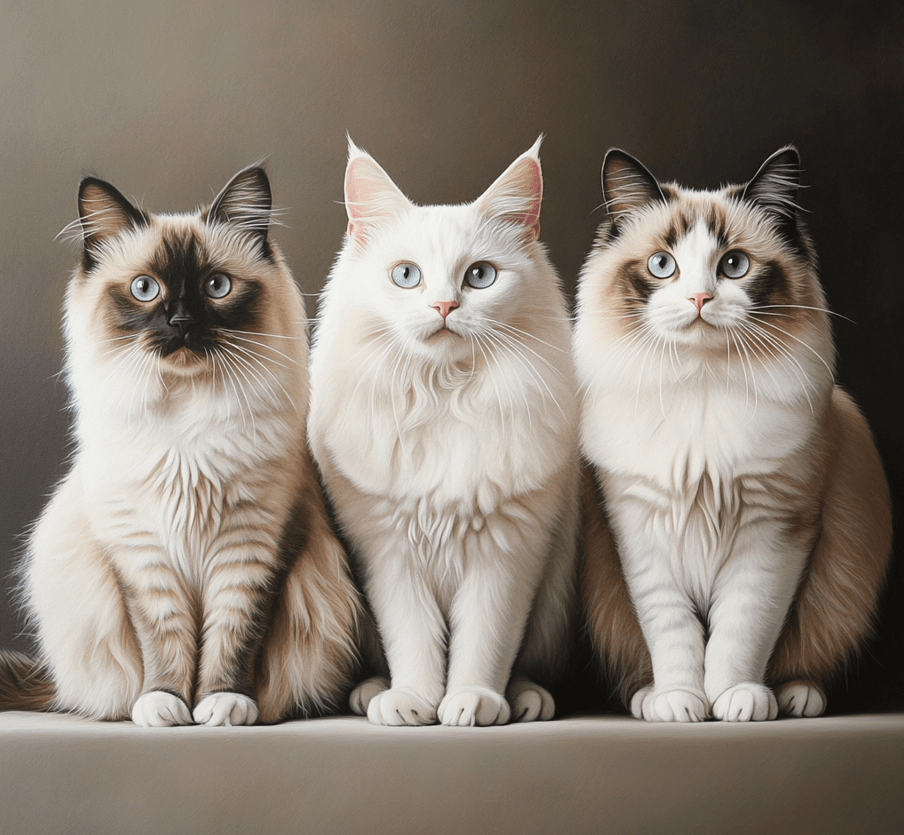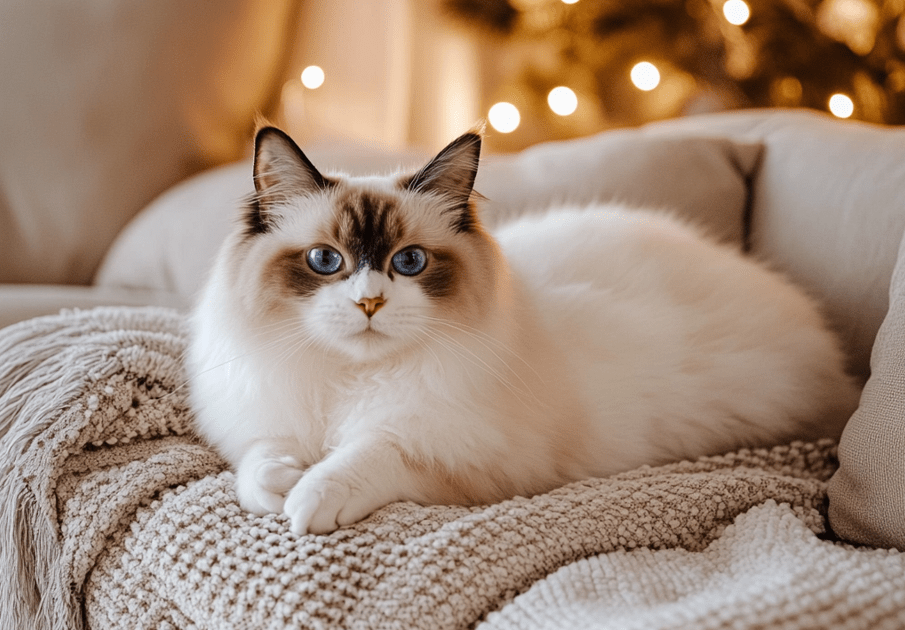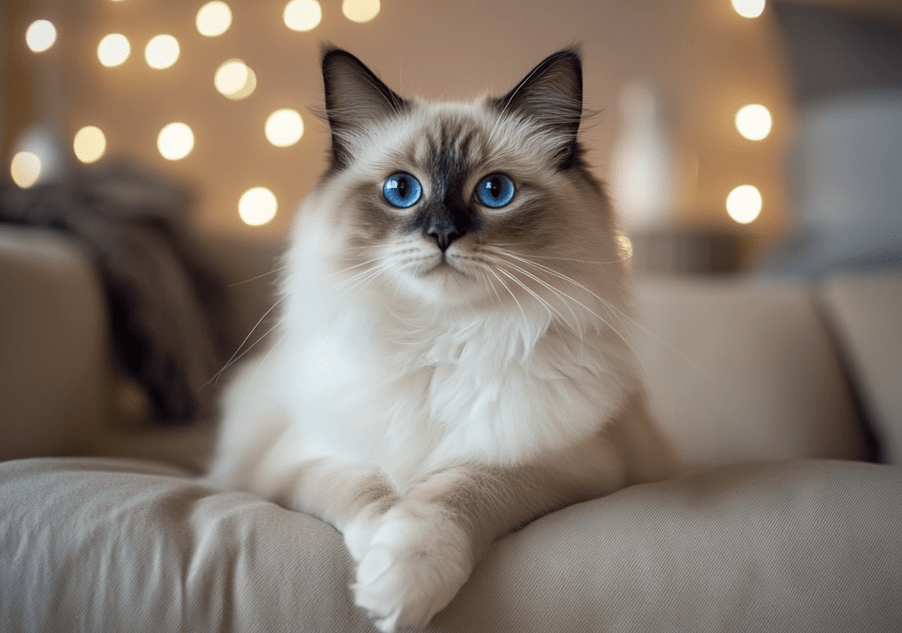
Ragdoll cat blue eyes are one of the most striking features of this beloved breed, captivating owners with their vivid, sapphire-like brilliance. These gentle, affectionate cats are known for their stunning appearance, but maintaining the health and vibrancy of their blue eyes requires proper care and attention. This comprehensive guide explores the unique characteristics of Ragdoll cat blue eyes, common eye health issues, and practical, vet-approved strategies to keep them bright and healthy, ensuring your Ragdoll thrives for years to come.
Introduction to Ragdoll Cats and Their Blue Eyes
Ragdolls are a cherished breed, celebrated for their docile temperament, luxurious coats, and mesmerizing blue eyes. The phrase Ragdoll cat blue eyes perfectly captures the allure of their gaze, which ranges from deep sapphire to soft sky blue. This distinctive trait is a hallmark of the breed, tied to their genetics and often linked to their pointed coat patterns. However, those beautiful eyes are sensitive and require diligent care to stay healthy and vibrant.
In this article, we’ll dive into why Ragdolls have blue eyes, the factors that affect their eye health, and actionable steps to protect them. From nutrition to grooming and regular vet checkups, we’ll cover everything you need to know to keep your Ragdoll’s eyes sparkling. Whether you’re a new Ragdoll owner or a seasoned enthusiast, this guide aims to be your ultimate resource for maintaining your cat’s eye health.
Why Do Ragdoll Cats Have Blue Eyes?
The captivating blue eyes of Ragdoll cats are a result of their genetics, specifically tied to the pointed coat pattern common in the breed. Here’s a closer look at the science and characteristics behind this trait:

1. Genetics of Blue Eyes
Blue eyes in Ragdolls are linked to the same gene responsible for their pointed coat colors, such as seal, blue, chocolate, or lilac. This gene affects melanin production, reducing pigment in the iris and resulting in the blue hue.
Pointed Gene: The Himalayan gene, present in Ragdolls, causes temperature-sensitive pigment production, leading to darker coloration on cooler body parts (ears, tail, face) and blue eyes.
Lack of Melanin: Blue eyes occur because the iris contains little to no melanin, allowing light to scatter and create the blue appearance.
2. Breed Standard
According to breed standards set by organizations like the Cat Fanciers’ Association (CFA), purebred Ragdolls must have blue eyes. Variations like green or yellow eyes may indicate crossbreeding or non-purebred status.
Consistency: All recognized Ragdoll coat patterns (colorpoint, mitted, bicolor) are associated with blue eyes.
Intensity: The vibrancy of the blue can vary, influenced by lighting, genetics, and overall health.
3. Sensitivity of Blue Eyes
Blue-eyed cats, including Ragdolls, are more sensitive to light due to the lack of pigment in their irises. This makes proper eye care essential to protect them from irritation or damage.
Common Eye Health Issues in Ragdoll Cats
While Ragdoll cat blue eyes are stunning, they can be prone to certain health issues. Understanding these conditions and their symptoms is crucial for early detection and treatment.
1. Conjunctivitis
Conjunctivitis, or inflammation of the eye’s outer membrane, is common in cats and can affect Ragdolls.
Symptoms: Redness, watery discharge, squinting, or pawing at the eyes.
Causes: Allergies, infections (viral or bacterial), or foreign objects.
Treatment: Veterinary-prescribed eye drops or ointments; cleaning the eye area gently.
2. Corneal Ulcers
Corneal ulcers are scratches or abrasions on the eye’s surface, often caused by trauma or foreign debris.
Symptoms: Excessive tearing, cloudiness, sensitivity to light, or rubbing the eye.
Causes: Scratches from play, dust, or untreated infections.
Treatment: Antibiotic or antiviral eye drops; in severe cases, surgery may be needed.
3. Tear Staining
Ragdolls, especially those with lighter coats, may develop tear staining, where reddish-brown streaks form under the eyes.
Symptoms: Discoloration or crusty buildup around the eyes.
Causes: Excessive tearing due to blocked tear ducts, allergies, or infections.
Treatment: Regular cleaning, addressing underlying causes, or vet-recommended tear stain removers.
4. Progressive Retinal Atrophy (PRA)
PRA is a genetic condition that can affect Ragdolls, leading to gradual vision loss.
Symptoms: Night blindness, dilated pupils, or bumping into objects.
Causes: Inherited genetic mutation.
Treatment: No cure exists, but early diagnosis can help manage symptoms and adapt the environment.
5. Glaucoma
Glaucoma involves increased pressure in the eye, potentially leading to vision loss if untreated.
Symptoms: Cloudy eyes, pain, redness, or enlarged pupils.
Causes: Congenital defects, injury, or secondary to other eye conditions.
Treatment: Medications to reduce pressure or surgery in severe cases.
6. Entropion
Entropion is a condition where the eyelid rolls inward, causing lashes to rub against the cornea.
Symptoms: Excessive tearing, squinting, or corneal damage.
Causes: Genetic predisposition or chronic irritation.
Treatment: Surgical correction in most cases.
How to Keep Your Ragdoll Cat’s Blue Eyes Healthy and Bright
Maintaining the health and vibrancy of your Ragdoll’s blue eyes requires a combination of proactive care, proper nutrition, and regular veterinary attention. Below are vet-approved strategies to ensure your cat’s eyes stay bright and healthy.

1. Regular Eye Cleaning
Daily or weekly cleaning prevents buildup and reduces the risk of infections or tear staining.
How to Clean:
1.Use a soft, damp cloth or vet-approved eye wipes.
2.Gently wipe from the inner corner outward to remove discharge or debris.
3.Avoid using cotton balls, which can leave fibers behind.
Frequency: Clean daily for cats prone to tear staining or as needed for others.
Products: Opt for pet-safe saline solutions or tear stain removers recommended by your vet.
2. Provide a Balanced Diet
Nutrition plays a critical role in eye health, supporting overall vitality and preventing conditions that affect the eyes.
Key Nutrients:
Vitamin A: Essential for retinal health; found in high-quality cat foods with animal proteins.
Taurine: Crucial for preventing retinal degeneration; ensure your cat’s food includes adequate taurine.
Omega-3 Fatty Acids: Reduce inflammation and support tear production; found in fish oil supplements or fortified foods.
Food Choices: Choose premium, vet-recommended wet or dry food formulated for feline health.
Hydration: Ensure access to fresh water to support tear production and prevent dehydration-related eye issues.
3. Schedule Regular Veterinary Checkups
Routine vet visits are essential for early detection of eye problems and overall health monitoring.
Frequency: Annual checkups for healthy Ragdolls; biannual for seniors or those with known issues.
Exams: Request a thorough eye examination, including checks for pressure, corneal health, and retinal function.
Genetic Screening: Ask about testing for PRA or other hereditary conditions if your Ragdoll’s lineage is unknown.
4. Protect from Environmental Irritants
Ragdoll cat blue eyes are sensitive to dust, smoke, and other irritants that can cause irritation or infections.
Clean Environment:
1.Use dust-free, low-tracking litter to minimize airborne particles.
2.Vacuum regularly to reduce dust and dander.
3.Avoid smoking or using strong chemical cleaners near your cat.
Allergy Management: If your Ragdoll has allergies, work with your vet to identify triggers and manage symptoms.
5. Monitor for Behavioral Changes
Changes in your Ragdoll’s behavior or appearance can signal eye issues.
What to Watch For:
1.Squinting, excessive blinking, or pawing at the eyes.
2.Cloudy, red, or watery eyes.
3.Changes in pupil size or vision-related behaviors (e.g., bumping into furniture).
Action: Contact your vet immediately if you notice any of these signs for a prompt diagnosis.
6. Grooming and Tear Stain Prevention
Proper grooming reduces tear staining and keeps the eye area clean.
Trim Fur: Keep the fur around the eyes trimmed to prevent irritation or tear duct blockage.
Tear Stain Solutions: Use vet-approved products to gently remove stains; avoid harsh chemicals.
Address Causes: Work with your vet to treat underlying issues like allergies or blocked tear ducts.
7. Provide a Stress-Free Environment
Stress can exacerbate health issues, including those affecting the eyes.
Safe Spaces: Offer quiet areas where your Ragdoll can relax.
Routine: Maintain consistent feeding, play, and sleep schedules.
Enrichment: Provide toys, scratching posts, and interaction to keep your Ragdoll mentally stimulated.
8. Protect from UV Light
Blue-eyed cats are more susceptible to UV-related eye damage due to low melanin in their irises.
Limit Sun Exposure: Keep your Ragdoll indoors during peak sunlight hours.
Window Filters: Use UV-blocking window films to reduce indoor light exposure.
Sunglasses (Optional): For outdoor Ragdolls, consider pet-safe goggles for fun, protective play.
9. Spay or Neuter Your Ragdoll
Hormonal changes in unspayed or unneutered cats can contribute to stress or health issues that indirectly affect eye health. Spaying or neutering promotes overall well-being and reduces these risks.
Preventing Eye Problems in Ragdoll Cats
Prevention is key to maintaining Ragdoll cat blue eyes in top condition. Here are proactive steps to minimize the risk of eye issues:
Early Socialization: Handle your Ragdoll gently from kittenhood to make eye cleaning and vet visits stress-free.
Regular Grooming: Incorporate eye cleaning into your grooming routine to catch issues early.
Safe Play: Avoid toys with sharp edges that could injure the eyes during play.
Health Monitoring: Keep a log of any eye-related symptoms to share with your vet.
Common Mistakes to Avoid
When caring for your Ragdoll’s eyes, steer clear of these pitfalls:
Using Human Products: Never use human eye drops or cleaners, which can harm your cat.
Ignoring Symptoms: Delaying vet visits for eye issues can lead to complications.
Over-Cleaning: Excessive wiping can irritate the eyes; follow a vet-recommended schedule.
Neglecting Diet: Poor nutrition can compromise eye health over time.
Conclusion

Ragdoll cat blue eyes are a breathtaking feature that deserves careful attention to stay healthy and vibrant. By understanding the genetics behind their stunning gaze, recognizing potential eye health issues, and implementing proactive care strategies like regular cleaning, proper nutrition, and veterinary checkups, you can ensure your Ragdoll’s eyes remain bright and beautiful. A stress-free environment, safe play, and early intervention for any issues will keep your cat’s sapphire eyes sparkling for years.
For personalized advice, consult your veterinarian or a feline specialist. With love and diligence, you can protect your Ragdoll’s blue eyes, enhancing their charm and well-being.




